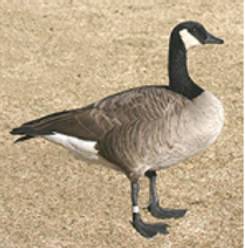It is always exciting to see a bird with a USF&WS aluminum band on a leg in Inyo County. If the nine-digit number can be read it means it can be determined where and when the bird was banded as well as the age and sometimes the sex. But it is usually very difficult to be able to read a number on the band of a bird that is not in the hand. Recently Jon Dunn and Jo Heindel were able to do that at the Bishop City Park because the bird was a Canada Goose with a big leg band. On 17 November 2004 the banded goose was surrounded while it grazed on the brown grass and 0868-52185 was carefully read.
Later that afternoon the band number was sent to the Bird Banding Laboratory at Patuxent, Maryland (1-800-347-BAND or http://www.pwrc.usgs.gov/bbl/). In a week a certificate was mailed out with the BBLs thanks for the effort and for information that had been sent. The certificate informed us that this bird was banded on 30 May 1997 at Sunnyside, Nevada, which is about 150 miles north of Las Vegas and about 195 miles east of Bishop. This is not a great distance as far as band recoveries go but considering that some of our visiting winter geese breed in northwest Alaska, it is an important piece of information. It was an AHY female (After Hatching Year) which means it was not born in 1997 but earlier, with the exact year unknown, making the bird at least eight years old. Through early December, there were eight geese in the Park with this bird the only one banded.
This banded goose was found as the result of looking hard at Canada Geese, which used to be one species. In July 2004 the American Ornithologists Union split the Canada Goose (Branta canadensis) into two species: Canada Goose (Branta canadensis) which includes all the large subspecies and Cackling Goose (Branta hutchinsii) which includes all the small subspecies. This has drawn birders back into the fields to look hard at white-cheeked geese to try to determine which are which. The smallest (Branta hutchinsii minima) is the only easy one because it is almost the size of a mallard and has a small bill and its size does not overlap any other subspecies. But the rest are challenging beyond belief. Sizes vary based on environmental and genetic factors which results in small birds of the larger group (Canada Geese) being smaller than large birds of the smaller group (Cackling Geese)!
Three of the eight in the Park were identified as two large Canada Geese (Branta canadensis moffitti) and one small Cackling Goose (Branta hutchinsii minima). The other five birds generated much debate regarding their identity. Some observers felt they were small subspecies belonging to the Canada Goose group and others felt they were large subspecies belonging to the Cackling Goose group. Never have so many people looked at so many white-cheeked geese for so long! This issue has been studied for seven decades by a few and now, with the many, it will probably take a decade or more to sort this all out. Ahhhh, the joy of science!

Canada Goose (Branta canadensis moffitti)
Photo by Jo Heindel

Cackling Goose (Branta hutchinsii minima)
Photo by Jo Heindel

